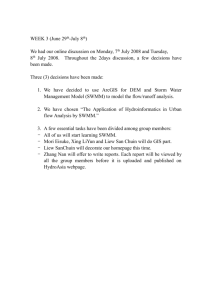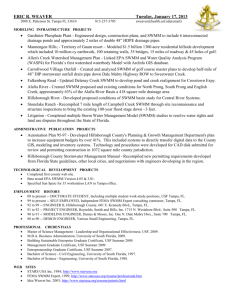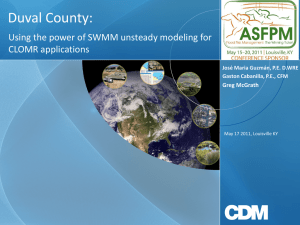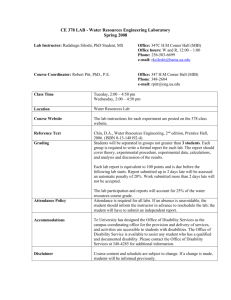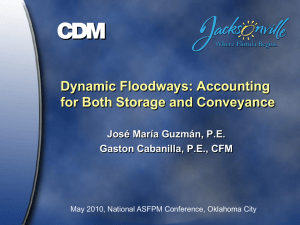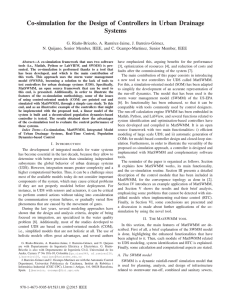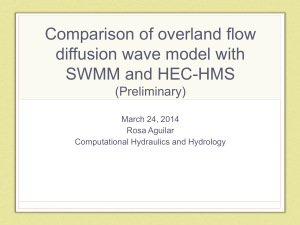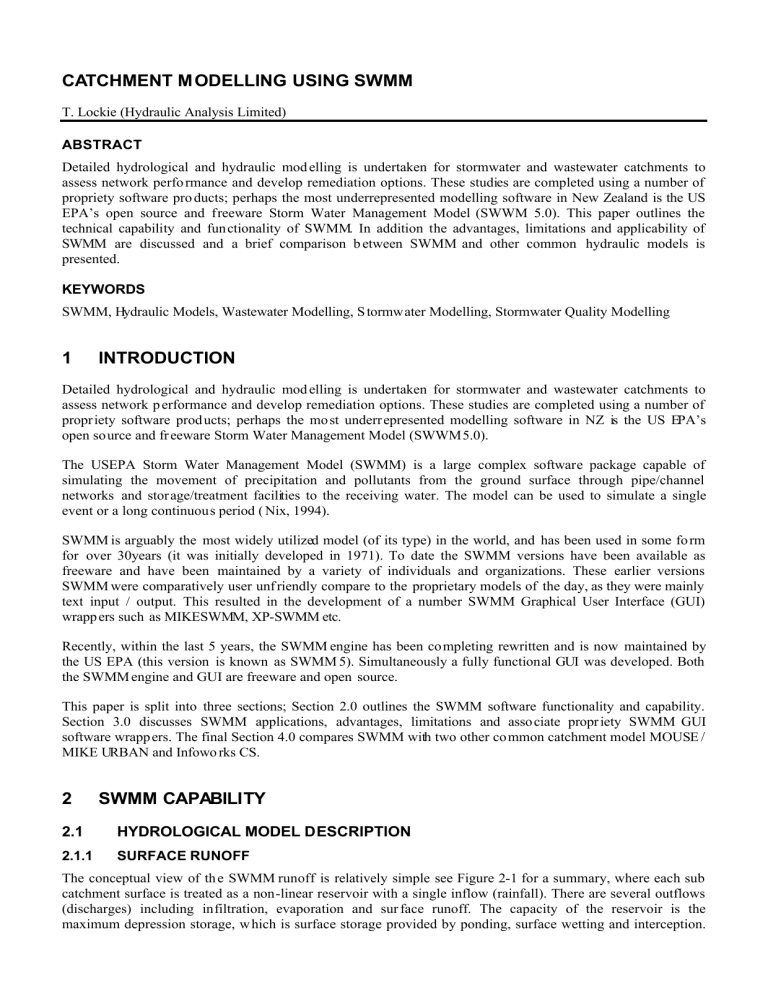
CATCHMENT MODELLING USING SWMM T. Lockie (Hydraulic Analysis Limited) ABSTRACT Detailed hydrological and hydraulic mod elling is undertaken for stormwater and wastewater catchments to assess network perfo rmance and develop remediation options. These studies are completed using a number of propriety software pro ducts; perhaps the most underrepresented modelling software in New Zealand is the US EPA’s open source and freeware Storm Water Management Model (SWWM 5.0). This paper outlines the technical capability and functionality of SWMM. In addition the advantages, limitations and applicability of SWMM are discussed and a brief comparison b etween SWMM and other common hydraulic models is presented. KEYWORDS SWMM, Hydraulic Models, Wastewater Modelling, S tormwater Modelling, Stormwater Quality Modelling 1 INTRODUCTION Detailed hydrological and hydraulic mod elling is undertaken for stormwater and wastewater catchments to assess network p erformance and develop remediation options. These studies are completed using a number of propriety software prod ucts; perhaps the mo st underrepresented modelling software in NZ is the US EPA’s open source and fr eeware Storm Water Management Model (SWWM 5.0). The USEPA Storm Water Management Model (SWMM) is a large complex software package capable of simulating the movement of precipitation and pollutants from the ground surface through pipe/channel networks and stor age/treatment facilities to the receiving water. The model can be used to simulate a single event or a long continuous period ( Nix, 1994). SWMM is arguably the most widely utilized model (of its type) in the world, and has been used in some form for over 30years (it was initially developed in 1971). To date the SWMM versions have been available as freeware and have been maintained by a variety of individuals and organizations. These earlier versions SWMM were comparatively user unf riendly compare to the proprietary models of the day, as they were mainly text input / output. This resulted in the development of a number SWMM Graphical User Interface (GUI) wrapp ers such as MIKESWMM, XP-SWMM etc. Recently, within the last 5 years, the SWMM engine has been completing rewritten and is now maintained by the US EPA (this version is known as SWMM 5). Simultaneously a fully functional GUI was developed. Both the SWMM engine and GUI are freeware and open source. This paper is split into three sections; Section 2.0 outlines the SWMM software functionality and capability. Section 3.0 discusses SWMM applications, advantages, limitations and asso ciate propr iety SWMM GUI software wrapp ers. The final Section 4.0 compares SWMM with two other common catchment model MOUSE / MIKE URBAN and Infowo rks CS. 2 SWMM CAPABILITY 2.1 HYDROLOGICAL MODEL DESCRIPTION 2.1.1 SURFACE RUNOFF The conceptual view of th e SWMM runoff is relatively simple see Figure 2-1 for a summary, where each sub catchment surface is treated as a non-linear reservoir with a single inflow (rainfall). There are several outflows (discharges) including infiltration, evaporation and sur face runoff. The capacity of the reservoir is the maximum depression storage, w hich is surface storage provided by ponding, surface wetting and interception. Surface runoff occurs on ly when the depth of water in the reservoir exceeds the maximum depression storage (USEPA SWMM, 2007). 2.1.2 INFILTRATION The water in storage is also being depleted by infiltration and evaporation. Infiltration occurs only if the ground surface is pervious. The infiltration process can be modeled by one of three different methods: § § § Horton’s Equation Green-Ampt Equation Curve Number Method Figure 2-1: Non-linear Reservoir Representation of a sub catchment in SWMM (USEPA SWMM, 2007) 2.1.3 AQUIFERS Aquifers are sub-surface groundwater areas used to model the vertical movement of w ater infiltrating from the subcatchments that lie abov e them. They also permit the infiltration of groun dwater into the drainage system, or exfiltration of surface water from the drainage system (USEPA SWMM, 2007). 2.1.4 RDII CURVES Rainfall-derived infiltration/inflow (RDII) uses Unit Hydrographs (UHs) to estimate flow into a sewer system. A UH set contains up to three such hydrographs, one for a short-term response, one for an intermediate-term response, and one for a long-term response (USEPA SWMM, 2007). 2.2 HYDRAULIC MODEL DESCRIPTION Flow routing in SWMM is governed by the conservation of mass and momentum equ ation for gradually varied, unsteady flow in one dimension (or as they are sometimes known the Saint Venant flow equ ations). SWMM offers three different levels of sophistication to solve these equations as follows: 2.2.1 STEADY FLOW ROUTING Steady Flow rou ting represents the simplest type of rou ting possible by assuming that within each computational time step flow is uniform and steady. Hence it simply translates inflow hydrographs at the upstream end of the conduit to the downstream end, with no delay or change in shape. The Manning equation is used to relate flow rate to flow area (or depth) (USEPA SWMM, 2007). 2.2.2 KINEMATIC WAVE ROUTING This routing method solves the continuity equation along with a simplified form of the momentum equation in each conduit. The latter requires that the slope of the water surface equal the slope of the condu it (USEPA SWMM, 2007). 2.2.3 DYNAMIC WAVE ROUTING Dynamic Wave routing solves the complete one-dimensional Saint Venant flow equations and therefore produces the most theoretically accurate results. These equations consist of the continuity and momentum equations for conduits and a volume continuity equation at nodes (USEPA SWMM, 2007). 2.3 WATER QUALITY MODEL DESCRIPTION 2.3.1 POLLUTANTS SWMM can simulate the generation, inflow and transp ort of any numb er of user-defined pollutants. Pollutant buildup and washoff fro m subcatchment areas are determined by the land uses assigned to those areas (USEPA SWMM, 2007). 2.3.2 LAND USES Land Uses are categories of development activities or land surface characteristics assigned to subcatchments. Land uses are used solely to account fo r spatial variation in pollutant buildup and washoff rates within subcatchments (USEPA SWMM, 2007). The following processes can be defined for each land use category: § § § 2.3.3 Pollutant Buildup Pollutant Washoff Street Cleaning TREATMENT Removal of pollutants from the flow streams entering any drainage system node is modeled by assigning a set of user defined treatment functions to the node. 2.4 ADDITIONAL MODEL FEATURES 2.4.1 TIME SERIES DATA Time Series objects are used to describe how certain object properties vary with time. Time series can be used to describe: § temperature data § evaporation data § rainfall data § water stage at outfall nodes § external inflow hydrographs at drainage system nodes § external inflow pollutographs at drainage system nodes § control settings for pumps and flow regulators 2.4.2 CURVES Curve objects are used to describe a fun ctional relationship between two quantities. The following types of curves ar e available in SWMM 5: § Storage - describes how the surf ace area of a Storage Unit node varies with water depth. § Shape - describes how the width of a customized cross-sectional shape varies with height for a Conduit link. § Diversion - relates diverted outflow to total inflow for a Flow Divider node. § Tidal -describes how the stage at an Outfall node changes by hour of the day. § Pump - relates flow through a Pump link to the depth o r volume at the upstream node or to the head delivered by the pump. § Rating - relates flow through an Outlet link to the head difference across the outlet. § Control -determines how the control settin g of a p ump or flow regulator varies as a function of some control variable (such as water level at a particular node) as specified in a Modulated Control rule. 2.4.3 REAL TIME CONTROL Real Time Co ntrols can be set up to determine how pumps, orifices and weirs in the drainage system will be adjusted over the course of a simulation. 2.4.4 PUMP STATIONS Pumps are links used to lift water to higher elevations. A pump curv e describes the relation between a pump's flow rate and conditions at its inlet and outlet nodes. Four different types of pumps are supported. 2.4.5 DRY WEATHER FLOW (DWF) SWMM 5 utilizes a Time P attern to simulate DWF profiles which allow external dry weather flow (DWF) to vary in a periodic fashion. They consist of a set of adjustment factors applied as multipliers to a baseline DWF flow rate or pollutant concentration. 2.5 SWMM USER INTERFACE The EPA SWMM main window (Figure 2-2) is pictured below. It consists of the following user interface elements: a Main Menu, several Toolbars, a Status Bar, the Study Area Map window, a Browser panel, and a Property Editor window. Figure 2-2: EPA SWMM Main Window (USEPA SWMM, 2007) 2.5.1 RESULT DISPLAY AND ANALYSIS Results can be displayed in the following ways: § § § § § Plan View (see Figure 2-2) Hydraulic Profile (see Figure 2-3) Time Series Plot (see Figure 2-4) Scatter Graph (see Figure 2-5) Tabular Data In addition to the above a Statistics Report can be generated from the time series of simulation results. For a given object and variable this report will do the following: § Segregate the simulation period into a sequence of non-overlapping events. § Compute summary statistics for the entire set of event values (mean, standard dev iation and skewness), § Perform a frequen cy analysis on the set of event values. 210 SWOUT0091 SWIN0034 200 SWMH0330 OC0058 OC0730 OC0729 OC0055 OC0054 Water Elevation Profile: Node OC0054 - SWOUT0091 12 11 10 9 8 Elevation (m) 7 6 5 4 3 2 1 0 -1 0 10 20 30 40 50 60 70 80 90 100 110 120 130 140 Distance (m) 150 160 170 180 190 220 230 240 250 260 01/02/2006 17:10:00 Figure 2-3: Hydraulic Profile Link SWOUT0045_SWIN0032 Flow 1.2 1.0 Flow (CMS) 0.8 0.6 0.4 0.2 0.0 0 5 10 15 20 ElapsedTime(hours) Figure 2-4: Time Series Plot Link SWSTOR003_SWIN0014 Flow v. Node SWSTOR003 Depth 0.08 Link SWSTOR003_SWIN0014 Flow (CMS) 0.06 0.04 0.02 0.0 -0.02 0 1 NodeSWSTOR003Depth(m) Figure 2-5: Scatter Graph 25 3 SWMM APPLICATIONS, LIMITATIONS AND ADVANTAGES 3.1 SWMM APPLICATIONS SWMM has been used in thousands of wastewater and stormwater studies throughout the world. Typical applications include: § § § § § § § 3.2 Design and sizing of drainage system components for flood contro l Sizing of detention facilities and their appurtenances for f lood control and water quality protection Flood plain mapping of natural channel systems (SWMM 5 is a FEMA-approved model for NFPI studies) Designing control strategies for minimizing combined sewer ov erflows Evaluating the impact of inflow and infiltration on sanitary sewer overflows Generating non-point source pollutant loadings for waste load allocation studies Evaluating the effectiveness of BMPs for reducing wet weather pollutant loadings. SWMM LIMITATIONS SWMM has a number of limitations, these include: • GIS Linkages - No GIS linkages have to either rely on propriety GUI’s or develop in house GIS linkages. • Numerical Instability – The SWMM hydraulic engine is slightly more unstable then other common hydraulic engines. However the engine is constantly undergoing upgrades which will gradually improve performance. • Simulation Speed – The SWMM hydraulic engine is slightly slower then other common hydraulic engines. Again the engine is constantly undergoing upgrades which w ill gradually improve performance. • Support – There is no f ormal support offered for EPA SWMM. A SWMM Users List serve, estab lished by the University of Guelph, allows subscribers to ask questions and exchange information. • NZ Experience – Only limited use of SWMM within NZ, hence there is limited experience with SWMM. 3.3 SWMM ADVANTAGES The perceived main advantages of the SWMM software for catchment analysis include: • • • • • The hydraulic engine of SWMM has been proven and tested since the early 1970’s and is reported to be the most widely applied stormwater and wastewater model in North America. The number of alternative software packages available on the market that utilize the SWMM hydraulic model as their basis also evidences this. The SWMM software is maintained by the US EPA. Due to these factors SWMM is considered very unlikely to become out of date or superseded in the near to medium future. SWMM is a free down loadable software package which offers the flexibility to TLA’s to release their developed SWMM models to local land developers and consultants for independent use as required i.e. the developers and/or their consultants do not need to pur chase expensive software to complete their analyses. While SWMM has a more basic interface and fewer in-built data management capabilities compared to the other 3 packages assessed, these aspects are considered to be of f-set by the free-availability of the package and robust hydraulic performance. A SWMM model constru cted using the US EPA user interface can be imported into a number more comprehensive user interfaces such as MIKE URBAN, XP-SWMM, and H20MAP SWMM etc. if more complex data management / result display features are required. SWMM is Open Source which has three main adv antages: o Firstly the modeler / engineer can read the code see exactly how the software simulates a certain process. o Being open source this allows the modelling community to contribute and develop the engine and incorporate additional features, for example a specific BMP device functionality could be coded and added as required. o Again being open source allows the code to be reviewed by a large num ber of people – far more than a prop rietary code this reviewing community allows the rapid identification bugs. 3.4 PROPRIETARY SWMM GUI WRAPPERS There are a nu mber of common catchment models that provide a GUI wrapper for the SWMM engine, these products include: § MIKEURBAN – Uses the SWMM 5.0 engine § H20MAP SWMM – Uses the SWMM 5.0 engine § MikeSWMM (freew are – uses the SWMM 4.4x engine) § XP SWMM (Utilizes a modified 4.4x engine) § PC SWMM While Infoworks cannot be considered a SWMM wrapper as it utilizes its own propriety hydraulic and hydrological engine. However many of the catchment objects have a one to one relationship with SWMM, for example Infoworks implements the following SWMM process: • The S WMM non-linear runoff model • Utilizes RDII curves • The S WMM aquifer object, • And implements the SWMM snowmelt model. Hence, prov iding the same functionality are utilized in the Infowo rks model, conversion between the two models should b e relatively straightforward. 4 SWMM FUNCTIONALITY COMPARISON WITH OTHER CATCHMENT MODELS COMMON The below Table 4-1 summarizes and compares current model functionality for SWMM, MOUSE / MIKE URBAN and Infoworks CS. As this table shows SWMM provides almost all of the functionality provided by the more the common propriety models, with the main weakn ess of SWMM being the more basic interface. Hence as this table shows all three models provide a similar level of technical performance, capability and reliability, with the main difference being the perfo rmance of the user interface and data management tools. Table 4-1: Model Functionality Comparison Topic Hydraulics Model Item SWMM 5.0 MOUSE / MIKE URBAN INFOWORKS CS Flow Routing Dynamic Wave Dynamic Wave Dynamic Wave Routing Engine Explicit numerical engine can have stability issues if the model not constructed and reviewed carefully. Implicit numerical engine, a stable and fast hydraulic engine. Though it is considered to be a slightly slower engine than InfoWorks. Implicit numerical engine. Generally considered the fastest and most stable fully dynamic engine. Inlet Control No No Yes Detention Storage Yes Yes Yes RTC Yes Yes Yes Pumps Yes Yes Yes Irregular XS Yes Yes Yes Utilizes a non-linear reservoir model to simulate runoff. Provides a number of surface runoff models, such as a time area method and a Kinematic wave model (Non Linear Reservoir Model). This model behaves exactly the same as the SWMM non-linear reservoir model Provides a number of surface runoff models, including the SWMM non-linear reservoir model. Surface Runoff Infiltration Provides three infiltration options, Cur ve Number, Horton’s Equation and Green Ampt. In addition to the RDII model (see below) MOUSE utilizes the Horton’s Equation or SCS Cur ve Number to simulate infiltration. Fixed PR Model (simple percentage) Green Ampt Model Horton Infiltration Model New UK PR Model Wallingford Procedure Model Constant Infiltration Model US SCS Model RDII Provides either unit hydrographs to simulate RDII or a groundwater infiltration module to simulate the influence of groundwater table on infiltration flow. MOUSE employs a complex RDII model. Provides either unit hydrogr aphs to simulate RDII or a groundwater infi ltration module to simulate the influence of groundwater table on infiltration flow. As per SWMM. Hydrology Water Quality Miscellaneous Use Ability Price Continuous Simulation Yes Yes Yes Pollutant Build Up / Washoff Yes Yes Yes Pollutants Modeled Yes Yes Yes Treatment Yes Yes Yes LTS - Job List No Yes - MOUSE provides a job list file which allows a selected number of events to be run by the HD model. No Statistics Yes Yes Yes User Interface Basic user interface. Good user interface. Sophisticated user interface. Data Management None Reasonable data management with the scenar io manager. Excellent data management. Result Display Reasonable Good Excellent Support No formal support, A SWMM Users List server, allows subscriber s to ask questions and exchange information. Comprehensive Comprehensive Purchase Cost Free ~$15k to $40k dependant on pipe limitation and modules selected. ~$30k to $60k dependant on node limitation selected. Maintenance Cost Free ~10% of the purchase price ~15% of the purchase price 5 CONCLUSIONS SWMM 5.0 is a freeware and open source software maintained by the US EPA. SWMM is a proven and tested model since the early 1970’s where SWMM provides a similar level of technical performance, capability and reliability to the common p ropriety catchment models, with the main difference being the perfor mance of the user interface and data management tools. However this limitation can be overcome if required through model customization or the purchase / use of one of the number of SWMM wrapper user interfaces which provide additional functionality. The below Table 5-1 summarizes the SWMM 5.0 software pros an d cons. Table 5-1: SWMM Use Pro’s and Con’s Pro's Freeware and Open Source Large user base Has been used in some form since 1971 Provides a similar level of technical performance, capability and reliability of other common catchment models. Con's No Support Hydraulic engine is slightly slower and suffers from more instabilities the other common propri ety engines Basic user interface, with limited data management tools. Limited NZ experience REFERENCES Nix, S. 1994. Urban Stormwater Modelling and Simulation , Boca Raton, Lewis Publishers. USEPA SWMM. June 2007. Storm Water Management Model User’s Manual Version 5.0 , EPA/600/R-05/040 Websites: DHI Ltd: http://www.dhigroup.com/Software/Urban/MIKEURBAN.aspx Wallingford Ltd: http://www.wallingfordsoftware.com/products/infoworks_cs/ SWWM: http://www.epa.gov/ednnrmrl/models/swmm/index.htm
